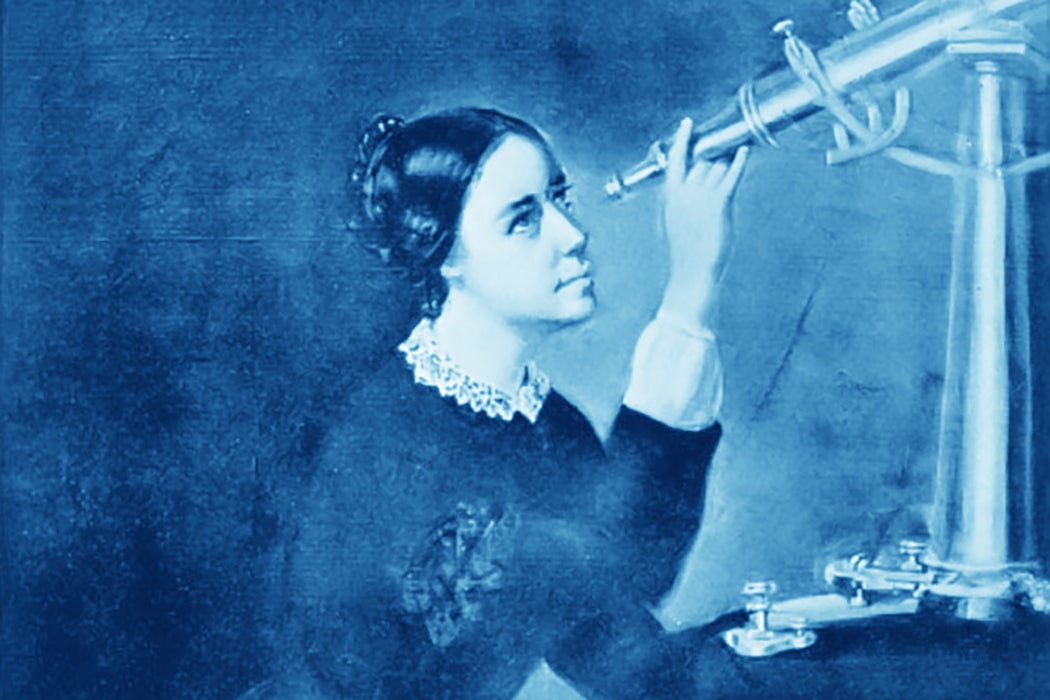On this day in 1818, Maria Mitchell was born. She would become America’s first woman astronomer. Science historian Sally Gregory Kohlstedt describes Mitchell as “well known among her contemporaries as the first woman to win an international medal, the first American woman elected to the American Academy of Arts and Sciences, the first woman member of the American Association for the Advancement of Science, and the first woman professor of astronomy.”
Mitchell was born on Nantucket Island to Quaker parents who believed that girls should be educated. Maria—pronounced “Ma-RYE-ah,” in the old-fashioned way—went to school and was tutored by her father. The cashier at the local bank, he taught her surveying and navigation. At the age of 12, Maria helped him calculate their position by observing a solar eclipse. At 14, she was computing navigation charts for local ships heading out on long whaling voyages.
As an adult, Mitchell became the first librarian on an island where women took charge of both civic and economic matters because men were away at sea for years at a time. She kept her eye on the skies, thought, and in 1847, she noticed something that wasn’t on any sky chart. It was a comet, soon to be known as “Miss Mitchell’s Comet.” The discovery made her internationally famous. She won a gold medal from the King of Denmark and was granted membership in the American Academy of Arts and Sciences—”in spite of being a woman,” according to the Academy’s own Report for 1848.
She toured Europe, where she met Caroline Herschel and Mary Somerville, among other luminaries. Upon her return, she was employed as a field researcher and “computer” for the U.S. Nautical Office. Kohlstedt describes Mitchell as probably the “only American woman to have self-supporting scientific employment and international recognition in the 1850s.”
As Kohlstedt notes, Mitchell’s successes “highlight the paucity of recognized women scientists in the nineteenth century. The barriers to women in science were high, limiting even to those on the periphery of the scientific community as illustrators, textbook authors and herbarium owners.” As a member of learned societies, Mitchell learned that “nominal membership conferred little sense of collegiality.” She “attracted more curiosity than professional interaction” at meetings of the Association for the American Advancement of Science, where she was also the first women member.
Kohlstedt thinks it significant that Mitchell “chose to work directly with women rather than to defy male hegemony.” And the feeling was mutual: Mitchell was cited with pride at the 1848 Seneca Falls Women’s Rights Convention. After her return from Europe, a group of wealthy American women gifted her a state-of-the-art telescope. In 1865, Mitchell became the first female professor of astronomy. She was actually the very first faculty member at the brand new Vassar College. As a result of her teaching, Vassar had more students in astronomy and math than Harvard did until 1888. When Mitchell discovered she was being paid less than younger male faculty members at Vassar, she demanded and got a raise; in her diary she wrote “given one wide awake woman in a town… you can rouse the whole.”
Want more stories like this one?
Mitchell was serious about involving women in science and advancing them in the field. Her stated incentives for this were that science was a way of thinking and problem-solving, and that a “unique intellectual challenges could help women escape the narrowness of their lives.” “We are women studying together” is how Mitchell introduced her advanced class. Kohlstedt notes that Mitchell was the only faculty member respected enough to not be branded with a student nickname.
The problem of course was what to do with young women educated in science. Often even their parents discouraged their taking such classes, and opportunities after graduation were extremely limited. Mitchell understood that male (and female) attitudes, domestic work, and lack of income prevented women from pursuing science. By the 1870s, as Kohlstedt details, she had become a major advocate for women’s rights. Her organizational skills and networking contributed to the “remarkable increase of women in science by the turn of the century”—which was some dozen years after her passing in 1889.







